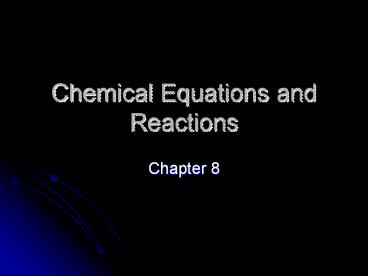Chemical Equations and Reactions - PowerPoint PPT Presentation
1 / 24
Title:
Chemical Equations and Reactions
Description:
Chemical Equations and Reactions Chapter 8 Chemical Reactions Def: process in which one or more substances are changed into new substances Start w/ REACTANTS and make ... – PowerPoint PPT presentation
Number of Views:199
Avg rating:3.0/5.0
Title: Chemical Equations and Reactions
1
Chemical Equations and Reactions
- Chapter 8
2
Chemical Reactions
- Def process in which one or more substances are
changed into new substances - Start w/ REACTANTS and make PRODUCTS
- Law of Conservation of Mass mass of reactants
must mass of products
3
Chemical Equations
- Def uses symbols and formulas to represent
identities of molecular or molar amts of a rxn - 2H2(g) O2(g) ? 2H2O(l)
4
Indications of Rxn
- Evolution of heat and energy as light
- Production of Gas (bubbles)
- Formation of precipitate (insoluble compound)
- Color change
5
Chemical Equations
- Word Equations
- Calcium Oxygen ? Calcium oxide
- Formula Equations
- Ca O2 ? CaO
- Remember HONClBrIF only for LONE element
- Balance Charges when needed
6
Symbols
7
Symbols
8
Complete Chemical Eqn
- BaCl2(aq) Na2CrO4(aq) ? BaCrO4(s) 2NaCl(aq)
- Formulas, Phases, Balanced
- 2Ca(s) O2(g) ? 2CaO(s)
- Solid sodium oxide is added to water and forms
sodium hydroxide (dissolved in water).
9
Balancing Equations
10
Balancing Equations
- Making a bicycle?
- 4 major parts ?
- Frame wheel handlebar pedal ? bicycle
- 1 Frame (F) 2 Wheels (W)
- 1 Handlebar (H) 2 Pedals (P)
11
Balancing Equations
- Bicycle
- FW2HP2
- Equation
- F W H P ? FW2HP2
- Unbalanced ? Balance it!
- F 2W H 2P ? FW2HP2
12
Balancing Equations
- H2 O2 ? H2O
- Count of atoms on each side of equation
- Can only change COEFFICIENTS!!
- Coefficients are in lowest whole ratio
- If can, treat polyatomic ions as one unit
- If equation isnt balancing equation is WRONG!
13
Balancing Equations
- FeCl2 Na3PO4 ? NaCl Fe3(PO4)2
- Al O2 ? Al2O3
- Li H2O ? LiOH H2
14
Types of Reactions
15
Types of Reactions
- Synthesis (combination)
- Decomposition
- Single-Displacement
- Double-Displacement
- Combustion
16
1. Synthesis Reactions
- Two or more reactants form ONE product
- A X ? AX
- 2Ca O2 ? 2CaO
- CO2 H2O ? H2CO3
17
2. Decomposition Reactions
- ONE compound broken down into two or more smaller
parts - Reverse of combination
- AX ? A X
- Decomposition usually requires something electric
? electrolysis, heat, catalyst, etc. - Ca(OH)2 ? CaO H2O
- 2KClO3 ? 2KCl 3O2
18
3. Single-Displacement Rxns
- A single element replaces another element in a
compound - A BX ? AX B
- Y BX ? BY X
- BX and AX are generally IONIC compounds ? A and
B are elements
19
Activity Series
- A MORE reactive metal will REPLACE a less
reactive metal - Pg. 286
- metals replace metals or H
- nonmetals replace nonmetals
- Cl2 KI ? ?
- Zn H2O ?
20
4. Double-Replacement Rxns
- Atoms or ions from two different compounds
replace each other - AX BY ? AY BX
- X and Y switch
- CaCO3 2HCl ? CaCl2 H2CO3
- HNO3 Ca(OH)2 ?
21
5. Combustion Rxns
- Substance combines with O2 releasing large amts
of heat and light - (C-H) Compound O2 ? CO2 H2O
- Similar to combination rxn
- CH4 O2 ?
22
Predict the Products
- Synthesis of Aluminum oxide from its elements.
- Combustion of ethane, C2H6
- Decomposition of calcium oxide to its elements
23
Reaction Rates
24
Rate-Influencing Factors
- Collision Theory reactions occur because of
collisions between particles - Inc. rate of reaction inc. collisions
- Surface Area
- Temperature
- Concentration
- Catalyst































